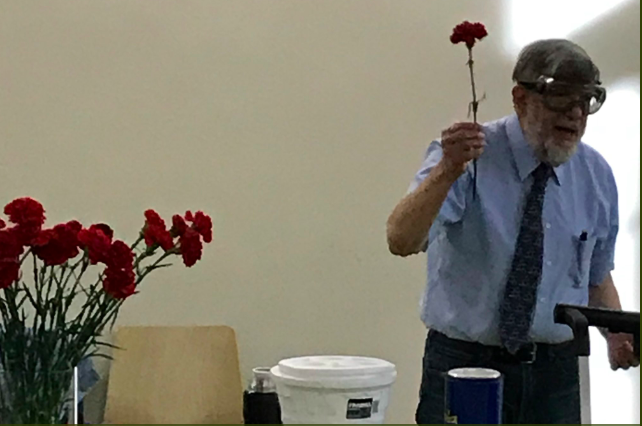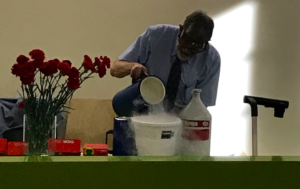HLF 2018: Is Bill Phillips The Coolest Guy In the World?

 HLF 2018 — Steer clear of the doors, Nobel physicist Bill Phillips warned us at the outset of his lecture here at the Heidelberg Laureate Forum this morning. And whatever you do, don’t sit in the first two rows of the lecture hall.
HLF 2018 — Steer clear of the doors, Nobel physicist Bill Phillips warned us at the outset of his lecture here at the Heidelberg Laureate Forum this morning. And whatever you do, don’t sit in the first two rows of the lecture hall.
These weren’t the first clues that the audience was about to get about as unorthodox a lecture on atomic physics that you could possibly imagine. After all, the HLF 2018 guide listed the title of Phillips’ talk as ‘Time, Einstein and the Coolest Stuff in the Universe.’ But still, the audience of world-famous math and computer science laureates and young researchers that gathers here for the HLF event every year never truly expected what came next.
What followed was a freewheeling exploration that improbably combined physics, humor, performance art, impressive amounts of liquid nitrogen (“the coolest stuff you’ve ever seen!”), balloons, frozen flowers, shattering racquetballs and, yes, even an explosion or two.
Amid a performance that had onlookers like Internet pioneer Vint Cerf, cryptography legend Whitfield Diffie and Google AI chief Jeff Dean grinning throughout, the Cornell-based atomic scientist managed to cogently explain the cooling and trapping of atoms with lasers and exactly why it matters.
 Laser atom cooling earned Phillips and colleagues Stanford’s Steve Chu and Collège de France’s Claude Cohen-Tannoudji, the Nobel Prize in physics back in 1997.
Laser atom cooling earned Phillips and colleagues Stanford’s Steve Chu and Collège de France’s Claude Cohen-Tannoudji, the Nobel Prize in physics back in 1997.
Today’s talk focused largely on how that technology is directly leading to the creation of the most accurate atomic clocks ever. But he managed to deliver some memorable insights regarding the future of quantum physics, Einsteinian physics and how atomic cooling might eventually drive quantum computing design.
Hopefully, within his lifetime — but certainly within those of the young researchers in the room, he said — such clocks could even be used to at last confirm Einstein’s equivalence principle, a bedrock of physics.
“It is such an exciting time to be alive!” he shouted exultantly at the end of the speech. And the audience, perhaps predictably at this point, went wild.
The coolest stuff in the world
A fellow at the National Institute of Standard and Technology, Phillips did follow a main thread thoughout his talk: and that was to describe what laser cooling tech is and how it will continue to help NIST to develop and operate the world’s most accurate atomic clocks.
But he didn’t start there. He started simply with the idea of time — what is it and how we measure it.
“Why is tomorrow always one day away?” he quipped in a classic Yogi Berra deadpan, before singing a bit of ‘Tomorrow’ from the musical, “Annie.”
“Before Einstein,” Phillips said, straightening up a bit, “people thought space and time were just part of an unchanging stage on which events played. But Einstein told us that the stage was part of the action.”
A matter of time
 “So what is time? It is simply what a clock measures,” Phillips continued.”But what is a clock? Well, there are many different kinds of clocks … and different clocks have different tickers.” Time is just about how you mention the ticks, he pointed out, and that is true whether those ticks are based on the stars that appear to move as the Earth turns or the tones of a classic Heidelberg-style cuckoo clock.
“So what is time? It is simply what a clock measures,” Phillips continued.”But what is a clock? Well, there are many different kinds of clocks … and different clocks have different tickers.” Time is just about how you mention the ticks, he pointed out, and that is true whether those ticks are based on the stars that appear to move as the Earth turns or the tones of a classic Heidelberg-style cuckoo clock.
But there’s a problem, he said, and that’s that fact “that all of these clocks’ tickers are imperfect. The length of a pendulum may stretch or shrink, and every quartz crystal is a little different from all the others, changing even with heat and humidity as it lies by your bedside. And even the rotation of the Earth is not constant. It is slowed by tides and affected by storms and ocean currents.”
The development of the atomic clock, which relies on measuring the state of Cesium atoms, is so important for this reason.
However, as accurate as atomic clocks are — and they are incredibly accurate — they are still imperfect “because they are limited by atomic motion.” That is, Cesium atoms, which move and have their states measured inside an atomic clock tube, cannot be a (near) perfect keeper of time because of that movement.
 That is why the technology for which Phillips and his team won the Nobel, cooling atoms and trapping them using lasers, has paved the way for ever more perfect clocks.
That is why the technology for which Phillips and his team won the Nobel, cooling atoms and trapping them using lasers, has paved the way for ever more perfect clocks.
Phillips work, it’s worth noting, has been credited over the years as a breakthrough discovery — not just for its utility in dramatically improving such applications as atomic clockmaking, but also in such fields as high-resolution spectroscopy, atomic lithography and quantum computing.
Demonstrating the technology to a group of people, however brilliant, with little or no background in the field was a mean feat. He used liquid nitrogen to demonstrate, with great hilarity, the effect of supercooling on moving atoms. In so doing, he turned balloons and flowers into flat, shattering frisbees and, memorably, demonstrated why you never want to put a closed bottle of liquid in the oven — or an NO2 bath.
“Your mother was right, you shouldn’t do that,” he told the group.
Watch Phillips describe the discovery that nabbed him the 1997 Nobel Prize in physics here. And you can watch Phillips’ unforgettable tour-de-force here at HLF 2018.
For HLF 2018, I’m Gina Smith.


Unser Herr Dr. Joachim Schulz gilt eigentlich – d-sprachig und die physikalische Bestimmung von Zeit meinend – als der überhaupt Coolste, oder?
Insgesamt stößt die E-Sprachlichkeit, die hier mehr und mehr Raum einnimmt, in diesem Biotop, die Scilogs.de meinend, einigen schon eher ungut auf.
Dies hier – ‘ “Before Einstein,” Phillips said, straightening up a bit, “people thought space and time were just part of an unchanging stage on which events played. But Einstein told us that the stage was part of the action.” ‘ – war so-o nicht korrekt angemerkt, denn es war Platon, der womöglich als Erster derart ausarbeiten und verbildlichen konnte.
Dieses Höhlengleichnis war und ist zentral, es leitet auch heute noch die skeptizistische Naturwissenschaftlichkeit an, denn es vermag, als Erstes, den Weltteilnehmer, das (nur) erkennende Subjekt, vom unbestimmt zu bleibenden Weltbetreiber, der kein Gott sein muss, zu trennen.
Es gab, insbesondere auch im 19. Jahrhundert, einige, die meinten, dass mit der Newtonschen Physiklehre nun sozusagen alles gegessen wäre.
Diese Leutz lagen falsch, sie inkulminierten sozusagen in der Doitschen Physik, wobei ihr grundsätzliche Fehler weniger im Nationalsozialistischen zu suchen war, sondern eben in der Missachtung Platons mit seinem kleinen Höhlengleichnis.
MFG
Dr. Webbaer
Alive and cool this fits together
That was an interesting article Gina. I think that we can also measure the entropy of the universe, calculate gravitational force tangent vectors and since E still equals Planck’s constant multiplied by the frequency, even Planck’s constant with the light amplification of stimulated emission of radiation and cooled atoms experiment, just to start with.
I hope to learn more about the dynamics of the gluons (in the language of particle physics, the strong nuclear force exchange particles g) being emitted and absorbed by the electrically charged and therefore massivated quarks in the nuclei while the nuclei and the electron clouds of 2 cooled entangled atoms that are in superposition to one another which gives us a quantum 2 state.